
8-12 September 2015. I am angry and disappointed. We have walked a long way from the entrance and I can see the blinding white travertine terraces spread out before us and there is no water in them. Where is the classic view of the extraordinary tiers of Pamukkale filled with turquoise water? Where is the view that appears in all the advertising such as in the photo above from the official government site? Where is the view that I have come so far to see that appears on all the postcards? Nowhere. The travertine is dry.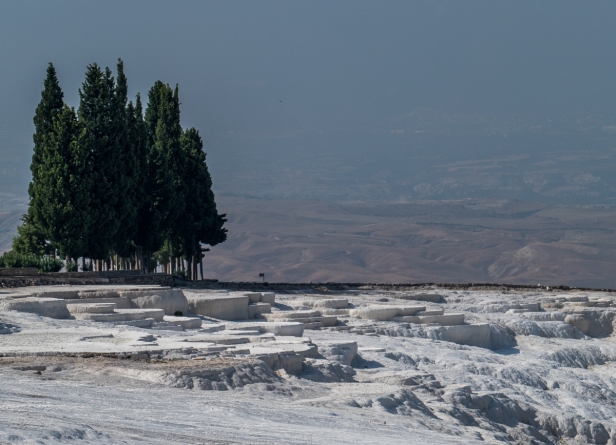


I ask and no one knows, or cares, when, or if, there will be water. I am angry and disappointed.
We had walked up from the lower entrance. The ‘path’ is alongside a cascade of man-made terraces where the water runs continually, flowing down from pool to pool, as well as in a gushing channel to the side. People may bathe here in the calcite-laden waters.

The channel of warm rushing water runs the length of the artificial terraces from top to bottom. My enduring image is of watching a family at play. Dressed in swimsuits, the man and his two sons are sitting in the channel immersed up to their waists, playing and laughing as the water gushes over them. The sun is shining down hot upon us all. The wife and mother wears a long skirt, a top of some sort, a full-length and long-sleeved coat, and a scarf wrapped over her head and tied under her chin. She stands beside the channel in her stockinged feet watching them.
Pamukkale means ‘cotton castle’ in Turkish. The landscape is formed by the mineral-rich waters continually flowing from above. A shifting fault line long ago allowed an opening for the water to escape from deep in the earth. On reaching the surface the calcium and hydrogen carbonate in the water react to create calcium carbonate, or travertine, and limestone. Slowly over the millennia as the water flowed away the minerals were left behind to harden and form the terraces. People have bathed in these pools for thousands of years. The dazzling white cliff of travertine is 2.7 kilometres (1.6m) long, 600 metres (1970ft) wide, and 160 metres (525 ft) high. From a distance it looks like a snow covered ski hill in the middle of semi desert.
We had arrived early hoping to beat the crowds,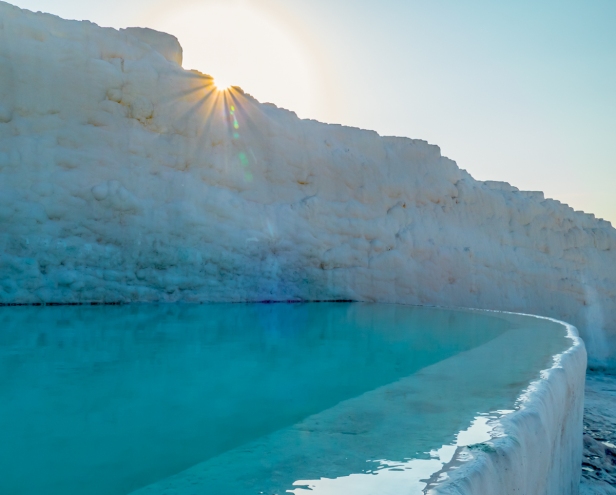
but unknown to us there is an upper entrance where busloads of people were being dropped off. By the time we had walked to the top it was getting busy. No matter. The complex is huge, and there was the ancient site of Hierapolis to explore.
While keeping an eye out for water being released into the natural terraces we explored the nearby ruins.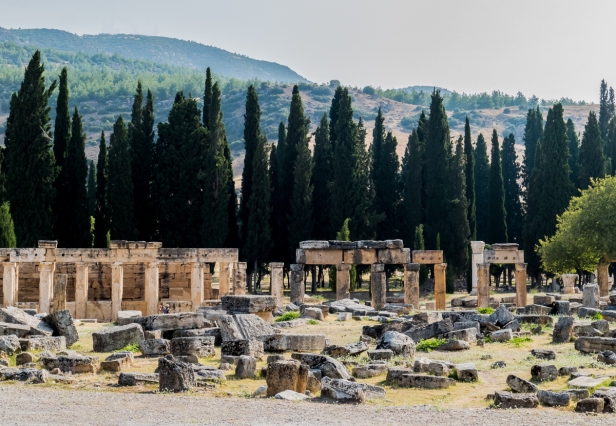
The Attalid kings of Pergamom founded Hierapolis, meaning holy city, at the end of the 2nd century BC at the site of an even more ancient cult. Not surprisingly by the time of the Hellenistic period it had become a well-known spa town. Hierapolis became a healing centre where doctors used the waters as treatment for their patients. After it was ceded to Rome in 133 BC the town flourished, reaching its peak in the second and third centuries AD. It became one of the most prominent cities in the Roman Empire in the fields of the arts, philosophy, and trade.

I can imagine this street as a smooth thoroughfare before earthquakes made it rutted. There are colonnaded buildings on either side housing government offices and shops. It’s busy with people going about their errands, in and out of the buildings, some greeting each other, some walking slowly, some swiftly. Families gathering. Merchants and tradesmen making deals. Children playing. Maybe there are studios where artists work, and the ancient equivalent of cafes where philosophers gather to discuss the meaning of life. The street retains its essence as a main thoroughfare, but now only hints at what it once was: humming with activity, and a place everyone in town knew and frequented.
All the time we’re exploring Hierapolis I’m hoping that as we walk along by the terraces on the far side past our central entrance point that there will be water in them and I’ll get to see the classic Pamukkale panorama. But no. There is no water anywhere except in the series of man-made pools. I’m angry. I feel as if there has been false advertising – all the advertising, every picture I’ve ever seen of Pamukkale has tiers of beautiful blue pools in the travertine. I feel cheated.
I find out that the information booth is way up at the south gate, a twenty-minute walk away, but by this time we’ve been here for six hours and it is time to go home.
Later in the day I return alone. As earlier, everyone is directed to remove their shoes at the gate to protect the surface. Once again I walk from the lower entrance barefoot over the travertine up past the man-made pools. It is surprisingly smooth underfoot.

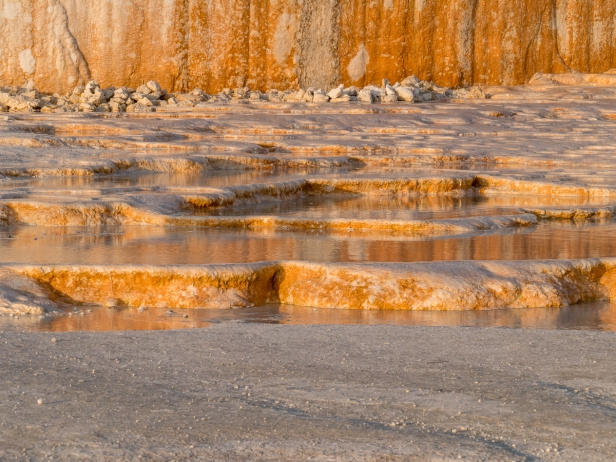
There is one section that has a little water in the upper level. I think it had been completely dry in the morning. Maybe for a while they’d directed the water in that area during the afternoon and I’d missed it, but I don’t see how it could have all drained away so quickly.
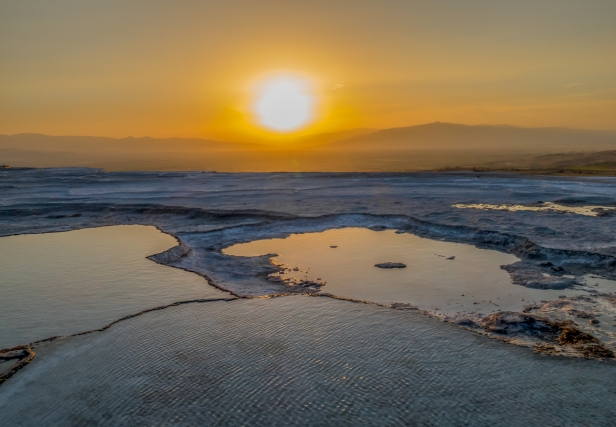
I walk the length of the travertine chasing the light. Off in the distance at the far end I can see a section that is clearly blue. Maybe that’s it! I hurry towards it only to discover it is just shadows in the dying light that makes it appear blue.
I am sad, but also glad that I’ve returned. In the soft golden light at the end of the day I experience a greater appreciation of this amazing landscape even without water. It’s not what I’d been expecting but it is still astonishingly unique and beautiful.
Next morning I wake up with the idea of driving to the south gate and asking at the information centre if they know when the water will be directed onto the terraces. The answer is today not at all, but tomorrow it will be, for most of the day. Please please please let it start in the morning because tomorrow we have to drive to Izmir to return the rental car. Today not at all. I think of the many tourists who come to Pamukkale on a one-day tour and are enticed by pictures of the blue water terraces.
Having established that it’s not worth another try at Pamukkale we drive for about half an hour to the beautiful and little-known Kaklik Cave.
Kaklik has the same travertine terraces as Pamukkale, but they are smaller and in a cave. It was discovered when the roof collapsed from natural weathering, and was opened to the public in 2002. It is 190 metres (623ft) long. In contrast to the crowds at Pamukkale we are alone in this extraordinary place. We are completely bowled over. It is stunning. We had not expected this. Wow! we keep saying. Wow!
Sunlight shining into the grotto at the entrance,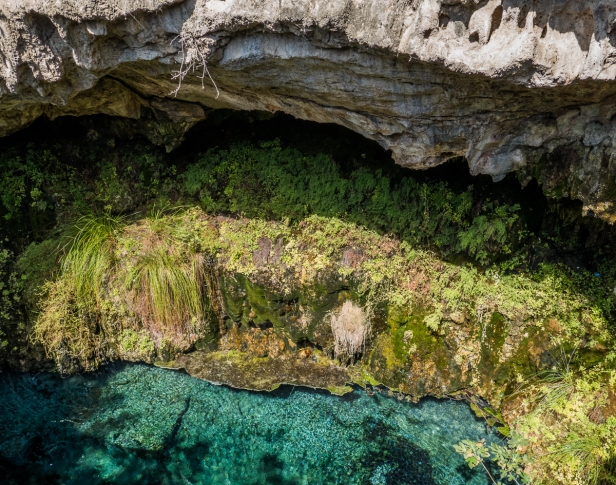
and inside the cave.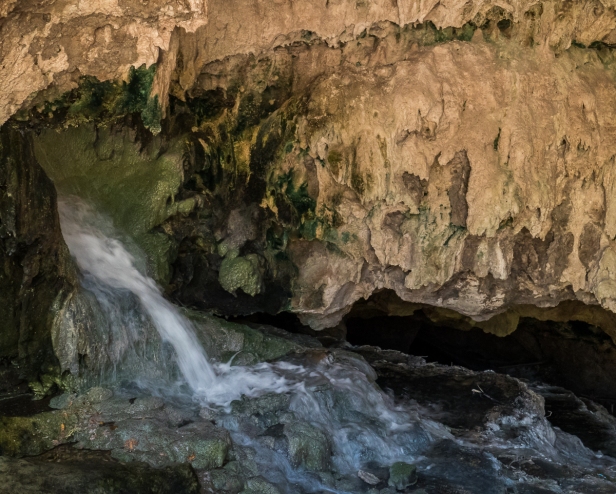


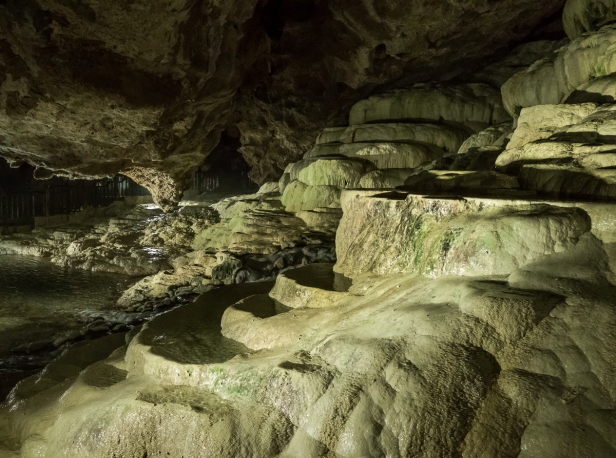


Next morning we are back at the Pamukkale information centre. The man there is unable to contact the people who can tell him when the water will be directed onto the terraces.
In the mid-twentieth century hotels were built above the travertine causing considerable damage and over-use of the water supply for spa pools. When the site was given World Heritage status the hotels were torn down, the man-made pools were built to help prevent further damage to the natural terraces, and the water flow controlled. All this is good, but in the two and a half days we spent there we did not ever see water in the natural terraces that remotely approached the images shown in all the classic scenes of Pamukkale, or in the images shown in all the advertising. If, like Don, I had not been expecting it I would have likely been enthralled rather than disappointed. On the other hand I had no expectations about Kaklik Cave and the experience was exciting and magical. A good lesson I think.
So we leave, and set out on the drive to Izmir. We drive through farming country:
trucks piled to twice their height with bales of hay or sacks of grain,
tractors with papa driving and mama and the kids in a flatbed trailer behind,
fields of olives, limes, corn, sugar cane, not yet ripe pomegranates, and figs,
and many roadside stalls selling figs and tomatoes.
Don passes a car doing about 120kph. The driver in the car waves his arm out the window signaling to Don to slow down. Sure enough police ahead! Phew! Thank you!
From Izmir we take an overnight train to Konya.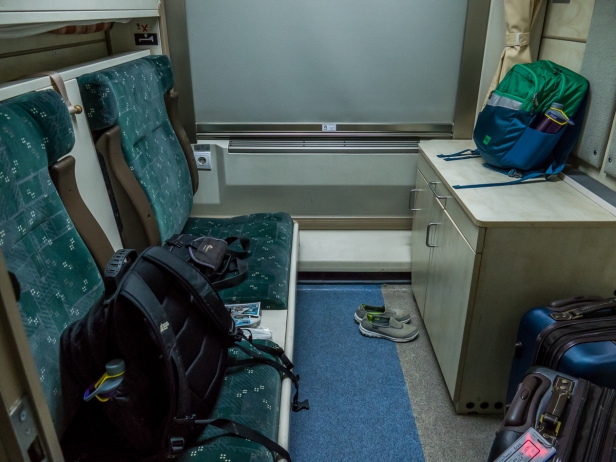
We are awake early, and I sit watching as the fields flow by in the golden glow of first light.
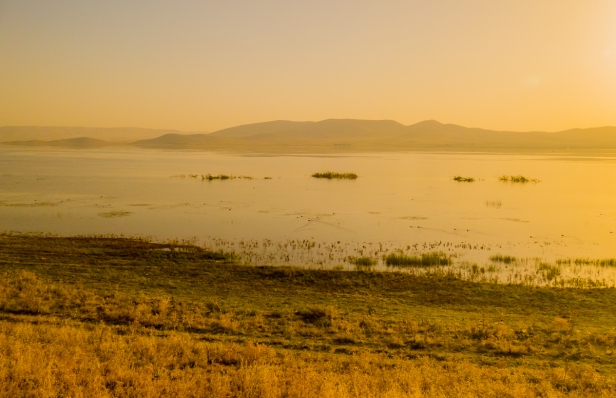




Next post: Konya – the birthplace of Sufism and the resting place of Rumi.
All words and images by Alison Louise Armstrong unless otherwise noted
© Alison Louise Armstrong and Adventures in Wonderland – a pilgrimage of the heart, 2010-2016.

Glorious photography and locale Alison. We booked Turkey for 2017! Hope you are having a wonderful time in San Miguel~
LikeLiked by 1 person
Thanks Cindy. It’s worth visiting even without water. We met a fellow Canadian in Cappadocia and she was at Pamukkale a week or so after us and posted a pic on FB with water in the terraces. We just lucked out I guess. I think I was as much upset about that as about missing the classic Pammukkale scene. What had happened to my serendipity mojo? It’s always been so reliable!
SMA is giving us what we need – access to healers at significantly less cost than we would pay in Vancouver to cure all our aches and pains. It’s a good place to rest for a while.
I’m sure you’ll love Turkey!
Alison
LikeLiked by 1 person
Well, I know how you feel to miss something you go to see. It’s a disappointment, and even though we know the words “no expectations” it is hard (maybe impossible?) not to have them and not to feel bad when something else appears in place of our expectations—for me anyway. It ALWAYS happens to me with scaffolding, whether it’s the Eiffel Tower or the Leaning Tower of Pisa. Scaffolding.
HOWEVER, for some reason, your photos in this collection are extremely marvelous. I love the underground cave shots. Natural light? Hand held? And those in the fields are so cool. Hey does your theme allow you to put those borders on, or you use something else? My theme used to allow borders, but WP “fixed” things, and now I can’t add borders.
LikeLiked by 1 person
Thanks BF. I too was pleased with some of these photos – the sunset ones at Pamukkale, the fields, and also the cave shots. The cave shots were hand held in very low light – high iso so they were very grainy, which can be adjusted in LR (at the expense of sharpness). You should try it 🙂
The fields were taken through a slightly hazy train window – very high shutter speed, and having the lens as close as possible to the glass so as not to get any reflections.
I’m certainly going to look at my expectations in future – remind myself that what I’ve read about or seen in pictures is not necessarily what I’ll get. And as I said to Cindy I was as much disappointed about the momentary loss of our serendipity mojo as about the lack of water.
We got scaffolding (restorations) at Shwe Dagon Pagoda and at Hagia Sofia. I know what you mean.
The photo borders come with the theme – I’ve never looked into whether or not they are optional, they’ve just always been there. I like them. Beware WP “fixing” things! Lol they should leave well enough alone!
Alison
LikeLike
That’s amazing…the cave shots by hand! You must have a steady hand. I used to carry a tripod, I’m just not doing that again!
The field shots are awesome. An artistic quality to them.
I’m pretty sure when I visisted Pamukkale, there was water everywhere. But I’ll have to take a look at those slides!
“Fixing” may have different connotations depending on…whatever!
LikeLiked by 1 person
Wow, this sounds and looks like a very different place from what we experienced in 1994—lots of water, no crowds. I’m glad you enjoyed the cave; I had not heard of it before reading your post. It is stunning.
LikeLiked by 1 person
I do wish I’d been there in 1994, or earlier. But then that applies to many many places around the world now. It is a good reminder to me that many places are relying on a reputation established long ago, and that what we get may have changed significantly. The cave was magical!
Alison
LikeLike
Oh Alison, I so understand the disappointment, when you have high expectations! However, be glad, because your photos are exquisite! The light is so beautiful, the colours so magical and ethereal….. really lovely! Thank you for sharing 🙂
LikeLiked by 1 person
Thanks so much danilam. I was really glad I went back at sunset – it gave me a new different appreciation for the place, and it was wonderful to get some good shots in that beautiful light.
Alison
LikeLike
Alison, your pictures are amazing in any case. I have never visited this area, it all looks so surreal, the caves are gorgeous.
LikeLiked by 1 person
Thanks so much Gilda. It is a truly remarkable place to visit, even if it didn’t meet my expectations. And that cave was a special bonus – gorgeous and surreal.
Alison
LikeLike
I know exactly what you mean when you describe the disappointment following the anticipation and expectations of seeing something M-A-R-V-E-L-O-U-S and then the let down when it’s not what was promised. However, your photos show a magical landscape of shades of white travertine terraces, the ruins of Hierapolis and the absolutely stunning caves of Kaklik. Along with your amazing photos you got the real bonus I love in travel – that feeling of discovery! Although you didn’t see what you expected my feeling is you turned the experience into something that was even better – just different. Anita
LikeLiked by 1 person
Thanks so much Anita.The whole place really was magical – especially after I got over my disappointment and could see it with fresh eyes a little bit. Hierapolis was fascinating, Pamukkale at sunset beautiful, and the cave was a fabulous spectacular bonus. I hope I have learned to remember to let go a little before we go anywhere. What we’ve been led to expect may not be what we get. And so much of Turkey was beyond expectations I really can’t complain.
Alison
LikeLike
Some things better left to the imagination, Alison? Such a shame because I know umpteen bloggers who were blown away by it. You still have some fabulous photos here. One to put down to experience. Have a happy weekend! 🙂
LikeLiked by 1 person
Thanks Jo. In the end I was pleased with my photos. I still kinda wish I’d been able to see Pamukkale with water in the terraces, but I guess it just wasn’t meant to be. We met a woman in Cappadocia who went there a week or so after us who saw water in the terraces. It never occurred to me it would be like a lottery! I will practice letting go of expectations beforehand in future 🙂
Alison
LikeLiked by 1 person
Loved your post Alison. It can be so difficult for any experience to live up to our expectations that have been created by looking through the eyes of someone else (or the tourist brochures). Really enjoyed your photos of the fields from the train – they were wonderful. Tim
LikeLiked by 1 person
Thanks Tim. I guess it simply never occurred to me that the Pamukkale terraces would have no water in them since every picture I’ve ever seen showed them filled with water. I should have done a little more research I guess. Anyway there was much I appreciated about our visit, and I’m really glad I went back at sunset. That made all the difference. I was pleased with the photos from the train too. Beautiful light. I just put my lens up against the window with high shutter speed and hoped for the best, but you never know what you’re going to get!
Alison
LikeLiked by 1 person
Maybe this was a case of being shown not what you wanted to see but what you needed to see. Either way, everything looks beautiful. Thank you for showing us this side of it. 🙂 xx
LikeLiked by 1 person
Harrrumph! Wanted to see what I wanted to see, not what I needed to see! Lol. It was very beautiful, and I guess what I needed to see is that it would be a good thing for me to let go of expectations a little in future to make room to see what is actually in front of me.
Alison
LikeLiked by 1 person
😉
LikeLiked by 1 person
Actually the landscape is stunning even without water. Yes, the beauty of not having expectations on a journey is that one encounters beautiful surprises and discoveries along the way. With expectations there is always room for disappointment and things not quite measuring up. It’s one of the reasons we tend to avoid the typical ” tourist sites” ( traps)…
Your photos of the landscape, especially the last image are quite lovely and painterly like.
LikeLiked by 1 person
Thanks Peta. I don’t know that I had expectations of other places we’ve been quite like I had for Pamukkale. Or other places lived up to my expectations. Either way I think I’ll let go a little more in future. We love out of the way places too, but some tourist sites really are worth visiting.
Alison
LikeLike
Your Kaklik Cave photos were glorious, and I was so impressed by the ruins with no crowds in sight. Like Don, I had no expectations, and was not at all disappointed. It is a lesson that I seem never to learn – most of the time, the world is beyond my control!
LikeLiked by 1 person
Thanks so much Marsha. I was really blown away by the cave – I certainly never expected anything like that! There were hundreds of people at Pamukkale and they were all in the water. Very few were interested in the ruins so we had the site to ourselves (unlike, say, the coliseum in Rome) – that was sweet. The world is beyond my control – like you I seem to need reminding frequently lol!
Alison
LikeLiked by 1 person
Awesome pictures! I can understand how sad you must have felt when entering Pamukkale and seeing all dry… At least when you went to Kaklik Cave you had the great opportunity to enjoy it all for yourself! Nice reading you from Buenos Aires.
LikeLiked by 1 person
Thank you so much Paloma. I was most disappointed, but I did appreciate how beautiful it was at sunset, and the cave was very special. We *loved* Buenos Aires. We spent about 3 weeks there in 2013. It’s a beautiful city.
Alison
LikeLiked by 1 person
Oh, I have written (too) many times about expectations and how they let us down. And the opposite: how the lack of expectations sometimes allows for something unimaginably dazzling. Many people have seen photos and the real, live turquoise water in those terraces; what a special treat you had to be able to capture that luminous travertine laid bare! 🙂
LikeLiked by 1 person
Now there’s a good re-framing of the situation – I got to see the terraces laid bare! I like that. Still wish I’d seen them with water as well 🙂
I can’t remember another time that I had such clear expectations and they weren’t met – which is really a statement about how very lucky we’ve been. And I also know that joy of discovering something completely dazzling and unexpected – e.g. Kaklik Cave. I think this experience will make me question expectations ahead of time in future – and then let go of them!
Alison
LikeLiked by 1 person
Unfulfilled promises are such a cruel cheat! Which, by the way, is why false advertising is really counterproductive. But as you say, it’s incredibly rewarding to find a surprising gem when you least expect it. A nicely told lesson for travellers …
LikeLiked by 1 person
Thanks Silk. I really think I learned something here. Not that I didn’t know before that it is better to let go of expectations, but because we’ve been so very lucky in our travels I think I had just become complacent about it. It seems to me we’ve always had our expectations met, and then some, so I’d stopped paying attention, and just assumed that our expectations would always be met. The irony is that the more we let go the more likely it is that our expectations will be met. I will pay more attention in future! 🙂
I think I have a bit of a trigger with false advertising – I hate being ripped off!
Alison
LikeLike
Fabulous pictures. Kaklik looks like a scene from Lord of the Rings! In spite of disappointments, there is always something amazing to see. The early morning fields are a sight to behold.
LikeLiked by 2 people
Thanks Darlene. Kaklik was amazing! So extraordinary and unexpected. And yes, there’s always something wonderful to see, as long as I have my eyes and heart open. The early morning fields were another unexpected delight. I have nothing to complain about!
Alison
LikeLike
Your amazing attitude has given you a wonderful life!
LikeLiked by 1 person
This looks like such a beautiful place Alison! You’ve been to so many amazing places! 😌
LikeLiked by 1 person
It really is a wonderful place. Even without the water it’s an extraordinary landscape. And Kaklik was a fabulous bonus. We *have* been to some amazing places! We are very blessed to have the life we have.
Alison
LikeLiked by 1 person
Are you still in Mexico now?
LikeLiked by 1 person
Yes, until the end of May.
LikeLiked by 1 person
Lovely! Enjoy! 🙂
LikeLiked by 1 person
I totally understand your disappointment. Pamukkale is a natural wonder that would be so cool if somehow kept in its natural state. Alas, it has been changed dramatically. I too, found that sunset was a special time. The view to the west across the valley is very dramatic and most of the people were gone when we visited.
The ruins above the travertine are quite cool. All in all, this has the potential to be a really special place, but alas it doesn’t quite live up to the hype I’m afraid.
LikeLiked by 1 person
I’m so glad I went back at sunset. It helped changed my perception. That lovely golden light helped a lot, but I do agree that Pamukkale no longer lives up to its hype. Kaklik was a treat.
Alison
LikeLike
So disappointed for you, Alison, but the photos are just wonderful. And I love the historical information. Sadly I won’t get to visit this beautiful country but your blog is the next best thing. Thank you so much. Safe travels and warmest wishes as always. Ros
LikeLiked by 1 person
Thanks so much Ros. It was a disappointment but there was much about visiting Pamukkale that was quite wonderful, especially when I went back for sunset. And Kaklik was fabulous. I’m glad you’re enjoying visiting all these places with us!
Alison
LikeLike
No matter how hard one tries not to have expectations, there are some places that just grab us and hold on, and even though we know we oughtn’t to expect anything, we do anyway. It’s especially hard when you’ve had a long string of places turning out to be even better than expected.
I really appreciate the honesty of this post, and that you felt comfortable writing about a less than ideal experience. As many of the folks here have said, the pictures you did post were incredible, and I very much enjoyed my vicarious visit to Pamukkale. But then, I had no expectations . . . 😉
LikeLiked by 1 person
Thanks Felicity. This was definitely one of those places that had just grabbed me and held on. Maybe I’ll get back one day and see what I wanted to see but probably not. We *have* had a long string of places turning out better than expected and I think that was partly the reason I was so upset – it was so completely unexpected to not get what I’d been hoping for! I was pleased with the photos – they do show what an amazing place it is even without water. I’m glad you enjoyed your visit 🙂
Alison
LikeLiked by 1 person
those grateful surprises ☺️❤️ beautiful post!
LikeLiked by 1 person
Thanks Hedy. Yes, after the disappointment wonderful surprises. I have no call to complain. Have a lovely day.
Alison ❤
LikeLike
Your photos are great. And many of them have beautiful, beautiful light. I have started following and am looking forward to read the back-posts too.
LikeLiked by 1 person
Thank you so much Louise. There’s nothing quite like the golden hour for photography. I didn’t know what I’d get photographing from the train window, but the light was so beautiful I had to give it a go. Thanks for following. I had a quick peek at your blog and look forward to exploring more.
Cheers, Alison
LikeLiked by 1 person
Beautiful photos. I hadn’t really considered Turkey for the bucket list, but now you’ve got me thinking…
LikeLiked by 1 person
Thanks so much Dave. Turkey is definitely worth visiting, and we didn’t even see all that much of it. We avoided the eastern part – too close to Syria/Iran/Iraq. There’s much to see and do there. Istanbul is a fabulous city, and the Cappadocia region truly extraordinary (post still to come about that). There are several more posts about Turkey – just enter Turkey in the search bar and they’ll all come up. And several more posts to come.
Thanks for following!
Cheers, Alison
LikeLiked by 1 person
Sounds good Alison. Looking forward to “more to come.”
LikeLiked by 1 person
The unexpected delights are the ones that linger in the memory longest. The feeling of awe in the Kaklik cave, especially being there on your own, comes through in the photos. I applaud the photos you caught from the train. I have many I tried to take from the Trans Mongolian express, blurred and so many with a tree or power pole front centre!!! And the light is beautiful, I lingered over them, they are like paintings. Even without water I found the images of the terraces quite beautiful, stark white, snowlike and pristine even without water. Yes advertising can lead to over expectations. The image you described of that Muslim woman is a sad statement of the culture that oppresses their freedom. How is Mexico? Are you there much longer? Then where?
LikeLiked by 1 person
Thanks so much pommepal. Kaklik Cave really was an unexpected wonder.
I was very pleased with the photos I got from the train. You never know what you’re going to get, but I knew the light was good. You need to have a very high shutter speed when taking photos from a train and try to get the lens as close to the window as possible without actually touching it. I was lucky the window was reasonably clean, but I think the haziness of the window gives that painterly feeling, as if I had a filter on the camera.
The terraces were very beautiful. It’s a surreal landscape. I’m glad to have been there even if it didn’t live up to expectations.
And, yes, the muslim woman. It is seared into my mind, a vignette that spoke volumes. I can’t know if she was happy or not, or just resigned, but I do know she doesn’t have the freedom that men and boys have and that makes me both sad and angry.
Mexico is wonderful – a beautiful town, some colourful festivals, and lots of healing for my poor sore hips and Don’s back. We are here until the end of May, then back to Canada for at least two months. After that we don’t know.
Alison
LikeLiked by 1 person
Pleased to hear your hips and Don’s back are recovering.
LikeLiked by 1 person
Have you been freezing again these last couple of days? Brrr!!! We arrived on Monday and were caught out in the downpour and hail on Tuesday. We have an apartment very near El Mirador. Great view! Long walk to centro!
We hope to meet you for coffee or a meal soon! We have not figured out how to use our local phone. Gave our number to some friends who are here, but they’ve not been able to get us. But if you would like to get in touch, you can reach me by email at k.rich72@yahoo.com
We’d love to meet you! You have been a big inspiration to us and are part of the reason we adopted this incredible lifestyle that we love!
LikeLiked by 1 person
You’re here in SMA! Yes we’re freezing too – it’s really crazy weather. Would love to get together for coffee. I’ll email you.
Alison
LikeLike
this is amazing!!
LikeLiked by 1 person
Thanks. We thought is was all pretty amazing too, even though I was disappointed with the lack of water. The cave also was a brilliant experience.
Alison
LikeLiked by 1 person
I might suggest there’s a difference between having expectations, and having trust in what you are told… I’m not sure it’s “having expectations” when I invite you over for a lasagna dinner and I offer you take-out cheeseburgers instead… Though I suppose the lesson holds true in terms of what you make of the moment. I would have felt a little deceived I think. Why not simply publish the water schedule?
It is interesting that the unintended consequence of protecting the site was reduced ability to enjoy it. If there is something we humans have mastered, it’s the art of unintended consequences! But the place still looked quite remarkable, with or without water, and the grotto, too. The sites of the ancient cities you’ve been showing us all seem quite beautiful. I wonder if our major cities of today had their beginnings in proximity to similar beauty, only we can’t tell anymore because of how they’ve grown and consumed the natural contours.
Much Love
Michael
LikeLike
Yes, we got the cheese burgers when they’d promised lobster. Publish the water schedule! What a concept, except I suspect that they do not always know it themselves. It still ires me a little – the false advertising, and them simply not caring about that, or possibly it not even occurring to them. The place *is* no doubt remarkable, and worth seeing. And the cave was fabulous.
I suspect many many cities had their beginnings in proximity to similar beauty. In some places it has been preserved and enhanced – Canberra comes to mind – though it is rare I think.
love,
Alison
LikeLike
One feels betrayed when there are photos everywhere of a beautiful place, yet when you arrive it is completely different. Belize comes to mind for us. There are pictures all over the net of gorgeous beaches and turquoise water, but in reality, Belize does not have these beaches at all, except on the outer islands. After waiting literally 20 years to get to Belize, we felt cheated, betrayed and disappointed. I feel your pain. Still, we are glad we went.
LikeLiked by 1 person
Yes it’s true Shirley, I did feel betrayed. And thanks for the warning about Belize. It’s been on our radar somewhat for a while. If we ever get there we’ll know what (not) to expect.
Alison
LikeLike
Hi…I wandered my way here but what a fantastic space you’ve created! I would love to read more about your travels…Please do visit my blog for some light hearted reads inspired by everyday moments! Cheers…
LikeLiked by 1 person
Thanks so much Aishwarya, I’m glad you’re enjoying the blog.
Alison
LikeLike
Such glorious pictures and a great lesson about expectations.
LikeLiked by 1 person
Thank you so much Susan. I hope I remember this lesson. When we’re travelling it’s hard for me not to get caught up in anticipation and excitement which usually comes from the info and pictures I’ve seen of a place. I’ll have to remind myself that it may not always be what I get.
Alison
LikeLiked by 1 person
hey
love your blog and great pics!
It would be really nice if you could visit my blog
https://amusantblog.wordpress.com/
Just started it this month. it would be great if you could give in some suggestions.
LikeLiked by 1 person
Thank you so much Angeline. I’m glad you like the blog.
I’ll pop over to your place 🙂
Alison
LikeLiked by 1 person
Pammukkale is indeed the stuff that dreams are made of. The blue waters seamlessly merge with the white shores to create a mesmerizing effect. Your pictures are stunning and have lovingly captured the beauty of the place. Apart from the natural charm of the place what fascinates is the history of the region and the fact that the place was a Spa city even in ancient times.
These pools look incredible, as do the Cleopatra ones. I’d definitely be staying the night to watch the sunset too, bet it’s magical!
LikeLike
Thanks so much Emily. This is indeed a place with a long history. Not surprising given the spa. We swam in the Cleopatra pool. And yes, the sunset did make up a little for not seeing water in the terraces. It really is a special place.
Alison
LikeLike
I loved my trip to Pamukkale. Your post reminded me of great memories from a few years ago. For those who stay for the night, the sunset was amazing. The place was almost empty and the colour contrasts looked fantastic.
I find it amazing to have two sites in one: the incredible scenery of pools + amazing ruins just next to it. Such a great place to visit! ❤️❤️❤️
LikeLike
I agree – it was a great place to visit, and I’m glad I was there for sunset. But of course I would have liked to see the terraces with water in them. Still, it’s a beautiful landscape and the ruins are quite amazing too.
Alison
LikeLike
Your blog is fantastic! Thanks for the information, I would! It’s such an unique place that I would love to see it with my own eyes one day 🌝
we’re planning on going in February any idea how crowded it will be? Also it sounds like we can get a room at that hotel get up early and just go for it no tour guide needed? ✈ This is a well-informed post.
Thank you for that. ❤
LikeLiked by 1 person
Thanks so much Codi. I hope you get to see Pamukkele. You don’t need a guide at all. You can stay nearby. We stayed in the village that’s within walking distance to the lower entrance. Just a little research online will give you all the info you need – that worked for us. Just don’t expect water in the natural terraces, only in the lower manmade terraces.
Alison
LikeLike
I was there ages ago, must come back! It was amazing and so extraordinary! It’s amazing that hot pools emerge from those snowy white plains. This is such a fantastic place to visit.
LikeLiked by 1 person
Yes I agree Maryum, it is a fantastic place. I’m so glad I ent there.
Alison
LikeLike
I was there ages ago, must come back! It was amazing and so extraordinary!
LikeLiked by 1 person
I think it’s an amazing place. I’d love to go back when there’s water in the natural terraces.
Alison
LikeLike
Like Don, having never seen ‘that view’ in the first picture, I enjoyed the views that greeted me in the subsequent three images … further driving home the point about expectations. The landscape is extraordinary with or without water, but if I’d shown up expecting water, I’d have been disappointed too.
The lower, tourist-filled, man-made water terraces were initially off-putting. But then your follow-up words of men laughing and children playing left a nice visual in my mind.
The ruins against the mountain were magnificent and your captures at twilight left me mouth agape; every one of them. I share your delight at your returning to this astonishingly unique and beautiful landscape as the light-enhanced it later in the day. And I just kept saying ‘wow’ as I worked my way through that cave
The wrap-up images with the morning glow gave me such a sense of peace.
I’m delighted to have discovered this post as yet another consolation to my ‘expectation’ filled disappointment at Vic Falls.
Thank you.
LikeLiked by 1 person
Thanks so much Lisa. I’m sure I’d have been awe-struck and thrilled by Pamukkale had I not had such fixed expectations. But I don’t know how we avoid that if we know something about a place beforehand and go because the pictures wowed us. You win some you lose some I guess. And poor Pamukkale – it really is an extraordinary landscape and I’m sooooo glad I went back for sunset and gained some appreciation of it.
I felt the same as you about the man-made pools though there’s no doubt people were having fun there and at least it’s a way to preserve the terraces from thousands of tourists.
Capturing those early morning images as the train made its way across Turkey was pure joy.
Alison
LikeLiked by 1 person
Oh I seriously feel your disappointment. I would have had no idea that sometimes the water is not released? I appreciate you sharing this with me after my disappointment with the Thailand long boats. It seems it is our own expectations that really set us up for this painful reality.
LikeLiked by 1 person
Isn’t it though! If only we could approach each place innocent, as if we’d never seen or heard of it before. Without expectations or hopes I think we’d see much more clearly.
Alison
LikeLiked by 1 person